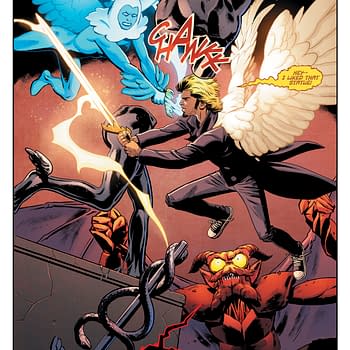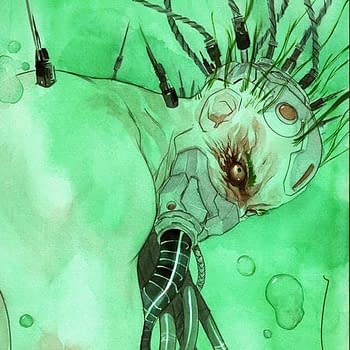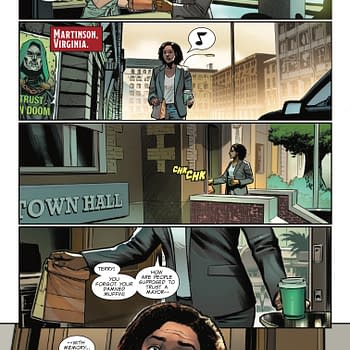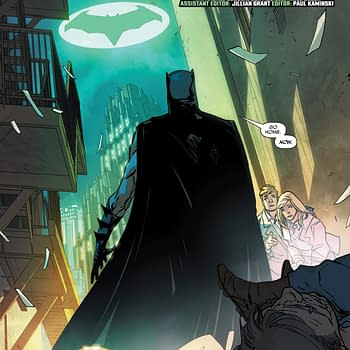Posted in: Comics, Recent Updates | Tagged: Birmingham International Comic Expo, brian bolland, Comics, dc comics, entertainment, grant morrison, ICE, joey cavalieri, Ladronn, rufus dayglo, tank girl, tony lee, will eisner
Joey Cavalieri, Tony Lee, And Rufus Dayglo Drop Wisdom At Birmingham International Comic Expo
By Olly MacNamee
Starting with DC legend Joey Cavalieri and ending my day listening in and chatting with Rufus Dayglo, I felt as though I learnt a great deal about the creation of comics and took away some great new ideas and skills – particularly in storytelling – that would inspire and enable many to create their own comic book. Here are some of the highlights from these panels that could help you create your own publication.
Joey Cavalieri
I was surprised to see that Cavalieri was using old titles such as the pre-NuDC's The Spirit and Zatanna to illuminate his keynote speech of the day, rather than his recent work on Future's End, but then he was taught by Will Eisner for two years at college and when you have cover art by the insanely talented Ladronn and Brian Bolland to show off, then who can blame the man.
While not necessarily commenting on just how much input an editor at today's DC actually has on a title (that would be discussed at subsequent panels instead, but in no way maliciously, just as a fact of today's publishing practices wherein changes can be made at both the writing and the art stages, often after the script/page is finished, as if all writers and artists have magic wands that can fix editorial changes 'just like that' to quote the late, great Tommy Cooper) Cavalieri did explain his average workload, which included having to commission 6 covers a month on top of other editing duties too. The commissioning of covers alone is 'a white knuckle ride' and 'always seems to take the whole month' to accomplish. Cavalieri often offers the cover artist his own thumbnails as a guide, with little deviation from this starting point, it would seem from the covers on display. But, don't get me wrong; this was not a dictatorial decision, but rather the eye of an editor with training in the arts himself.
At DC, because of its use of full scripts, Cavalieri claimed that 'the writer gets most control' and not the artist. This was a point of debate in my mind but I could see his point given the amount of detail put into a script by the writer working the DC method.
A good piece of advise handed to the audience was the inclusion of what Cavalieri called 'the exotic'; something that would draw the reader in, even if the story was set in Manchester, England, as one Spirit story was. As someone who lived for nigh on a decade in Manchester, sometimes the exotic was hard to find.
Using The Haunted Tank series of a few years ago, humorously Cavalieri talked us through some of the challenges he – and the artist, Phil Winslade in this instance – would have when you are producing a comic that is essentially a title focusing on a tank and a group of characters all looking the same thanks to their military uniforms. I mean, 'there's only so many ways you can present a tank in an interesting and entertaining way'.
Oh, and if you are currently enjoying the art of Howard Porter as he continues to stun in Justice League 3000, then you've got Cavalieri to thank partly for this. Apparently, several years ago, Porter was becoming disillusioned with comics. It was Cavalieri, upon looking through one of Porter's sketchbooks that encouraged him to experiment more with his line work. This led to a Demon Knights cover (issue 23) and a renaissance for the artist that continues today. Pick up a copy of Justice League 3000 to see what I'm talking about. It really is stunning and, when compared to the work he was producing for Grant Morrison in JLA, seems to be from the pen of a completely different artist.
See, editors aren't all bad after all. Joey seems to be one of the good guys.
Tony Lee: Creating Lies for Fun and Profit
This was truly a master class on storytelling and one of the best talks for would-be comic book writers I have attended in recent memory. Certainly far too much to condense down into a brief summary that would even begin to give Lee the credit he deserves for this illuminating talk, but that won't stop me waxing lyrical nonetheless. While other panels from the day covered ground many fans would have already been aware of (e.g. making notes on thumbnails submitted by the artist to his/her editor) this was an hour or so of new ideas on the whole. From covering the complexities of the comic book layout – ensuring that the 'money shot' comes at the correct time, i.e. after the turn of the page and not before and sacrificing panels to do so – to sowing the seeds of the narrative via the placing of 'Chekov's guns' (every object – gun, sword, whatever – in the story should have a function in the narrative) to working backward from your ending, I walked away from this panel with ideas I was keen to interject into my own teaching on creative writing to my own GCSE and A Level pupils. None of us, even this English teacher, are too old to learn new tricks.
At one point Lee made us of both an interesting and comical analogy to illustrate the need to keep your readers invested was the world of American wrestling and the WWE. Each and every week the WWE honchos have to keep the crowds entertained. It's not just fake fighting for rednecks y'know. The good guy can turn bad, or even team up with others, but will always return to their original depiction. You can see this illusion of change in comics all the time, whether its Spider-man's recent troubles with Doc Ock or Superman's current dalliance with Wonder Woman. Heck, when Wolvie dies this Autumn, does anyone really believe it will last? These are entertaining aspects that keep a character relevant and fresh and keep a reader invested but, eventually, the dial will always be turned back and history reset. Spidey will always be unlucky in love and Supes will always have Lois Lane and Wolverine will always be indestructible.
This is not to say the character cannot develop. Indeed, as Lee pointed out, they must, or else not much is achieved.
What was interesting, as someone who has written recently for DC Comics' Superboy series, was his won take on writer/artist collaboration. Unlike Cavalieri, Lee wants his artists to soar, to take control of certain aspects of the comic. He knows if there's a fight to be illustrated, chances are the artist will illustrate this better than the writer can describe it prosaically and he's not afraid to simply leave 'hero and villain fights for three pages' as instructions. Not so much a contradiction as a favoured way of working. I was starting to learn that no one artist, writer or editor works in the same way. And, comics, are still the hardest thing he's ever had to write, and that's including screenplays. You've been warned.
Rufus Dayglo
Mesmerized equally by both his stunning art and his tattoos (the best I've seen a comic book artist display, his arms adorned with different comic book panels illustrating Kirby's Silver Surfer and McMahon's Dredd as well as others) Rufus spoke to just a handful of people but that made it all the better as no-one was afraid to speak up and what started off as a well planned talk on the process of drawing and laying out a story – using his FCBD Judge Dredd strip as an example – became a cozy chat with wannabe artist of the future with plenty of sound advise.
For instance, to make a panel look busy, Rufus makes us of layers in Photoshop, a no-brainer really, but something I hadn't even considered doing myself on those odd occasions I still find time to draw.
To create tone, Dayglo will often include gray scale into his pencil work before adding colour in Photoshop. This way, when even applying flat colour, shade and depth can easily be achieved. Indeed, one editor upon receiving his penciled artwork thought they were viewing the completed inked pages. Looking at examples of that very same art, I could see why he/she was fooled. The pencils were ultra tight and all smudges had been painstakingly removed with an eraser.
While Rufus still set out his characters in the order they spoke (left to right) Lee had previously commented that he did not always follow this golden rule. Not for the first time was I given advise that may have seemed contradictory but really only again let me, and others, know that will there are guidelines there are no general rules that cannot be subverted or experimented with at any level of the comic book production.
From the editor's perspective and through the eyes of the writer and the artist I was left feeling inspired, as I know many of my fellow comic-con attendees were too. These talks, as well as the top draw talent at the con and no wonder for the first time in a long time, I spent all day at this particular comic con. I learnt a lot and look forward to reading further works by Cavalieri, Lee and Dayglo with the insight I now have of their working processes and practices.
Thanks for a great con guys, one and all.
Olly MacNamee teaches English and Media, for his sins, in a school somewhere in Birmingham. Some days, even he doesn't know where it is. Follow him on twitter @ollymacnamee or read about his exploits at olly.macnamee@blogspot.co.uk. Or don't.



















